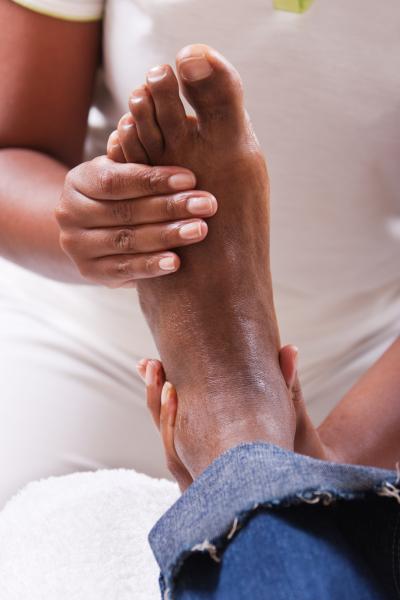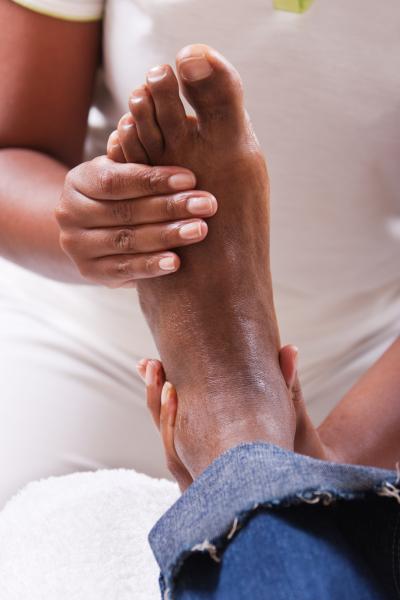
Credit: Getty Images
Sidney Brown thought the mole on his nose was just an annoying pimple. He didn't consider that it could be a cancerous tumor, because, Brown thought, "skin cancer is something white people get."
The misconception that people with more pigment — called melanin — in their skin cells are protected from cancer-causing ultra-violet rays nearly cost Brown his life.
Brown's mole turned out to be a melanoma, the least common form of skin cancer, but also the deadliest. While most people associate skin cancer with sun exposure, melanomas are more likely to be caused by genetics than the sun's ultraviolet radiation, and far more likely to develop on sun-protected areas of the body in blacks, Hispanics and Asians.
May is Melanoma/Skin Cancer Detection and Prevention Month, the occasion for numerous messages about the importance of limiting time in the sun and using sunscreen. While those protective actions are important, they can mislead people into making the same dangerous mistake Brown made.
"The misconception that the sun is responsible for all cases of melanoma leads to lower survival rates because of delayed diagnosis, particularly among people of color," explains Arthur Rhodes, MD, MPH director of the Rush Melanoma Surveillance Clinic. Rhodes estimates that only ten to 15 percent of melanomas are caused by excessive sun exposure, typically in heavily freckled and sun-damaged skin.
'Anyone – regardless of skin color – may develop melanoma'
Brown, who is black and a father of two, wasn't worried about the mole on his nose until it began to change. "It started out flat. I didn't really pay much attention to it, because I had an oily face and pimples on my nose anyway," he says."So when I saw the black mark, I didn't think much about it. But then it kept irritating me, itching. Then it grew into a lump." His primary care doctor referred him to Rhodes, who quickly diagnosed the mole as cancerous. "He explained that once a mole starts growing up, it is also spreading cancer cells down through the body. That can be too late for many, but catching mine in time saved my life." Brown recalls.
A 2016 American Academy of Dermatology study, "Racial Disparities in Melanoma Survival," showed that while melanoma incidence is higher in whites, death rates are relatively higher among people of color.
"Far too often, black, Hispanic, and Asian patients with melanoma cancer tell us they believed that melanoma was only a danger for sun-seeking whites," the researchers write in their report of the study findings. "But anyone – regardless of skin color – may develop melanoma, in both sun-exposed and sun-protected sites. Not noticing or ignoring a new or changing mole in a sun-protected site can be fatal."
Early diagnosis key to survival
Melanomas develop from skin cells called melanocytes, which reside in the superficial layer of the skin called the epidermis. Melanocytes in the epidermis produce pigment (melanin) that gives the skin its color and protects skin cells from the damaging effects of the sun's ultraviolet radiation.
Abnormal varieties of melanocytes cause common skin growths known as moles. Most moles are harmless, but unique varieties of atypical moles may develop into melanoma.
While less common than other types of skin cancer, melanomas are deadlier, because the malignant cells can spread even though the tumor is relatively small and not bleeding or causing pain or itching. This capacity to metastasize underlies the importance of early detection, especially among people of color.
Rhodes stresses the need for monthly self-examination and examination in difficult-to-see areas on the body in family members, seeking the presence of a new mole, or a change in a pre-existing mole – a change in size, shape or color. Some of the most aggressive forms of melanoma may occur on areas that receive little or no direct sunlight.
Melanoma is reason for sole searching
A delayed diagnosis is common for melanomas in these difficult-to-self-examine sites. "Early diagnosis results in a cure, while delayed diagnosis may be deadly," Rhodes warns.
"Half of all melanomas in non-whites occur on the palms of the hands, soles of the feet, nailbeds, mucous membranes, perianal area, genitalia, and other areas that are not exposed to the sun, areas that are difficult-to-self-examine and commonly ignored."
Melanoma in a relatively hidden site will tend to thicken without symptoms or signs, leading to a delayed diagnosis that may result in a higher melanoma death rate, especially for people of color, including blacks, Hispanics, and Asians.
Since Rhodes removed his cancerous melanoma ten years ago, Brown has been counseling friends and family to pay closer attention to their skin. "Dark-skinned people think it's nothing," Brown says.
"A lot of times we get moles, and we don't think anything about it. Don't accept that it can't be something; go see what it is. Don't say 'Eh, (melanoma is) something that white people get.'"
Melanoma Risk Factors
According to the Rush Department of Dermatology, a variety of physical, historical, and genetic traits increase the risk for developing melanoma, including the following:
- Having a mole present within the first two weeks of life (a birth mole) (10-fold increased risk)
- Having a personal history of melanoma (nine-fold increased risk)
- Having a family history of melanoma (eight-fold increased risk)
- Having numerous moles and/or atypical moles (eight-fold to 40-fold increased risk)
- Having had a Spitz tumor removed (eight-fold increased risk)
- Having had an atypical nevus removed (seven-fold increased risk)
- Having had at least 2 moles removed in the past (five-fold increased risk)
- Prior treatment for psoriasis with more than 200 PUVA treatments (psoralen pills and ultraviolet A radiation) (five-fold increased risk)
- Having had a basal cell cancer or squamous cell cancer (four-fold increased risk)
- Presence of dense sun-induced freckles (three-fold increased risk)
- Immune suppression related to disease or medication (three-fold increased risk)
- Having red hair (two-fold increased risk)
- Having Parkinson disease (two-fold increased risk)
- Multiple sunburns in early childhood (two-fold increased risk)
###
Media Contact
Charles Jolie
[email protected]
312-942-7817
@RushMedical
http://www.rush.edu
############
Story Source: Materials provided by Scienmag





